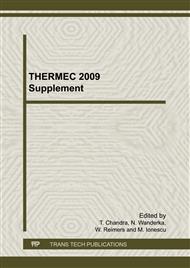p.147
p.153
p.159
p.165
p.171
p.177
p.184
p.190
p.196
High Pressure Torsion of Pure Ti: Effect of Pressure and Strain on Allotropy
Abstract:
High-pressure torsion (HPT) was conducted on commercial grade pure titanium (99.4%) by applying pressures in a wide range from 1.2 to 40 GPa. When the microhardness was plotted against equivalent strain, the hardness saturates to a constant level at each applied pressure. Such a level at the saturation depends on the applied pressure: for up to the pressure of 4 GPa, the saturation level is independent of the pressure but, for the pressures above 4 GPa, the hardness gradually increases with pressure because of the formation of an phase. Bending tests showed that an excellent ductility as well as high bending strength was achieved for the sample processed at 2 GPa. The bending ductility was reduced for the sample at 6 GPa because of the phase formation.
Info:
Periodical:
Pages:
171-176
Citation:
Online since:
January 2010
Authors:
Price:
Сopyright:
© 2010 Trans Tech Publications Ltd. All Rights Reserved
Share:
Citation:


